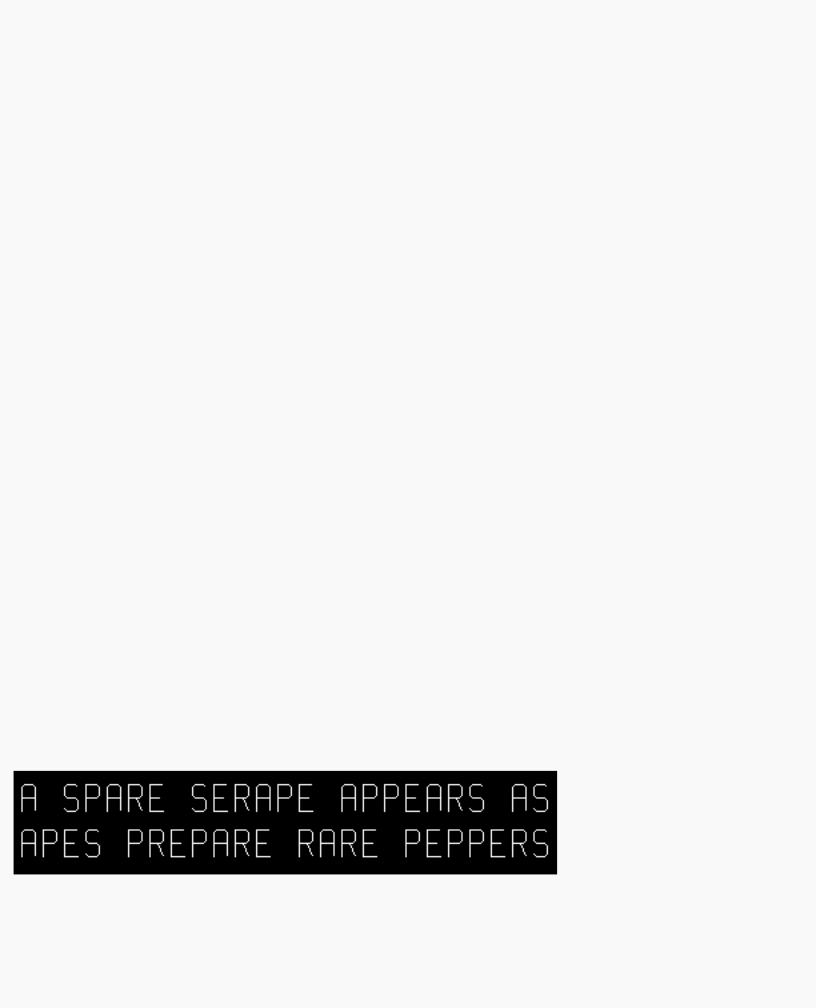
The Official Guide to Learning OpenGL, Version 1.1 (Redbook Second Edition)
.pdf
OpenGL Programming Guide (Addison-Wesley Publishing Company)
set the same material properties are ignored.
It may improve performance to store state settings with geometry. For example, suppose you want to apply a transformation to some geometric objects and then draw the result. Your code may look like this:
glNewList(1, GL_COMPILE); draw_some_geometric_objects(); glEndList();
glLoadMatrix(M);
glCallList(1);
However, if the geometric objects are to be transformed in the same way each time, it is better to store the matrix in the display list. For example, if you were to write your code as follows, some implementations may be able to improve performance by transforming the objects when they are defined instead of each time they are drawn:
glNewList(1, GL_COMPILE); glLoadMatrix(M); draw_some_geometric_objects(); glEndList();
glCallList(1);
A more likely situation occurs when rendering images. As you will see in Chapter 8, you can modify pixel transfer state variables and control the way images and bitmaps are rasterized. If the commands that set these state variables precede the definition of the image or bitmap in the display list, the implementation may be able to perform some of the operations ahead of time and cache the result.
Remember that display lists have some disadvantages. Very small lists may not perform well since there is some overhead when executing a list. Another disadvantage is the immutability of the contents of a display list. To optimize performance, an OpenGL display list can't be changed and its contents can't be read. If the application needs to maintain data separately from the display list (for example, for continued data processing), then a lot of additional memory may be required.
Creating and Executing a Display List
As you've already seen, glNewList() and glEndList() are used to begin and end the definition of a display list, which is then invoked by supplying its identifying index with glCallList(). In Example 7-2, a display list is created in the init() routine. This display list contains OpenGL commands to draw a red triangle. Then in the display() routine, the display list is executed ten times. In addition, a line is drawn in immediate mode. Note that the display list allocates memory to store the commands and the values of any necessary variables.
Example 7-2 : Using a Display List: list.c
#include <GL/gl.h> #include <GL/glu.h>
http://heron.cc.ukans.edu/ebt-bin/nph-dweb/dynaw...Generic__BookTextView/14035;cs=fullhtml;pt=12800 (7 of 21) [4/28/2000 9:46:03 PM]

OpenGL Programming Guide (Addison-Wesley Publishing Company)
#include <GL/glut.h> #include <stdlib.h>
GLuint listName;
static void init (void)
{
listName = glGenLists (1); glNewList (listName, GL_COMPILE);
glColor3f (1.0, 0.0, 0.0); /* current color red */ glBegin (GL_TRIANGLES);
glVertex2f (0.0, 0.0); glVertex2f (1.0, 0.0); glVertex2f (0.0, 1.0); glEnd ();
glTranslatef (1.5, 0.0, 0.0); /* move position */ glEndList ();
glShadeModel (GL_FLAT);
}
static void drawLine (void)
{
glBegin (GL_LINES); glVertex2f (0.0, 0.5); glVertex2f (15.0, 0.5); glEnd ();
} |
|
|
|
|
void display(void) |
|
|
|
|
{ |
|
|
|
|
GLuint i; |
|
|
|
|
glClear (GL_COLOR_BUFFER_BIT); |
|
|
||
glColor3f (0.0, |
1.0, 0.0); |
/* |
current color green |
*/ |
for (i = 0; i < |
10; i++) |
/* |
draw 10 triangles |
*/ |
glCallList |
(listName); |
|
|
|
drawLine (); |
/* |
is this |
line green? NO! |
*/ |
|
/* |
where is the line drawn? |
*/ |
|
glFlush (); |
|
|
|
|
}
void reshape(int w, int h)
{
glViewport(0, 0, w, h); glMatrixMode(GL_PROJECTION); glLoadIdentity();
http://heron.cc.ukans.edu/ebt-bin/nph-dweb/dynaw...Generic__BookTextView/14035;cs=fullhtml;pt=12800 (8 of 21) [4/28/2000 9:46:03 PM]

OpenGL Programming Guide (Addison-Wesley Publishing Company)
if (w <= h)
gluOrtho2D (0.0, 2.0, -0.5 * (GLfloat) h/(GLfloat) w, 1.5 * (GLfloat) h/(GLfloat) w);
else
gluOrtho2D (0.0, 2.0*(GLfloat) w/(GLfloat) h, -0.5, 1.5); glMatrixMode(GL_MODELVIEW);
glLoadIdentity();
}
void keyboard(unsigned char key, int x, int y)
{
switch (key) { case 27:
exit(0);
}
}
int main(int argc, char** argv)
{
glutInit(&argc, argv);
glutInitDisplayMode (GLUT_SINGLE | GLUT_RGB); glutInitWindowSize(650, 50); glutCreateWindow(argv[0]);
init ();
glutReshapeFunc (reshape); glutKeyboardFunc (keyboard); glutDisplayFunc (display); glutMainLoop();
return 0;
}
The glTranslatef() routine in the display list alters the position of the next object to be drawn. Without it, calling the display list twice would just draw the triangle on top of itself. The drawLine() routine, which is called in immediate mode, is also affected by the ten glTranslatef() calls that precede it. So if you call transformation commands within a display list, don't forget to take into account the effect those commands will have later in your program.
Only one display list can be created at a time. In other words, you must eventually follow glNewList() with glEndList() to end the creation of a display list before starting another one. As you might expect, calling glEndList() without having started a display list generates the error GL_INVALID_OPERATION. (See "Error Handling" in Chapter 14 for more information about processing errors.)
http://heron.cc.ukans.edu/ebt-bin/nph-dweb/dynaw...Generic__BookTextView/14035;cs=fullhtml;pt=12800 (9 of 21) [4/28/2000 9:46:03 PM]

OpenGL Programming Guide (Addison-Wesley Publishing Company)
Naming and Creating a Display List
Each display list is identified by an integer index. When creating a display list, you want to be careful that you don't accidentally choose an index that's already in use, thereby overwriting an existing display list. To avoid accidental deletions, use glGenLists() to generate one or more unused indices.
GLuint glGenLists(GLsizei range);
Allocates range number of contiguous, previously unallocated display-list indices. The integer returned is the index that marks the beginning of a contiguous block of empty display-list indices. The returned indices are all marked as empty and used, so subsequent calls to glGenLists() don't return these indices until they're deleted. Zero is returned if the requested number of indices isn't available, or if range is zero.
In the following example, a single index is requested, and if it proves to be available, it's used to create a new display list:
listIndex = glGenLists(1); if (listIndex != 0) {
glNewList(listIndex,GL_COMPILE);
...
glEndList();
}
Note: Zero is not a valid display-list index.
void glNewList (GLuint list, GLenum mode);
Specifies the start of a display list. OpenGL routines that are called subsequently (until glEndList() is called to end the display list) are stored in a display list, except for a few restricted OpenGL routines that can't be stored. (Those restricted routines are executed immediately, during the creation of the display list.) list is a nonzero positive integer that uniquely identifies the display list. The possible values for mode are GL_COMPILE and GL_COMPILE_AND_EXECUTE. Use GL_COMPILE if you don't want the OpenGL commands executed as they're placed in the display list; to cause the commands to be executed immediately as well as placed in the display list for later use, specify GL_COMPILE_AND_EXECUTE.
void glEndList (void);
Marks the end of a display list.
When a display list is created it is stored with the current OpenGL context. Thus, when the context is destroyed, the display list is also destroyed. Some windowing systems allow multiple contexts to share display lists. In this case, the display list is destroyed when the last context in the share group is destroyed.
What's Stored in a Display List
When you're building a display list, only the values for expressions are stored in the list. If values in an array are subsequently changed, the display-list values don't change. In the following code fragment, the display list contains a command to set the current RGBA color to black (0.0, 0.0, 0.0). The subsequent change of the value of the color_vector array to red (1.0, 0.0, 0.0) has no effect on the display list
http://heron.cc.ukans.edu/ebt-bin/nph-dweb/dynaw...Generic__BookTextView/14035;cs=fullhtml;pt=12800 (10 of 21) [4/28/2000 9:46:03 PM]

OpenGL Programming Guide (Addison-Wesley Publishing Company)
because the display list contains the values that were in effect when it was created.
GLfloat color_vector[3] = {0.0, 0.0, 0.0}; glNewList(1, GL_COMPILE);
glColor3fv(color_vector); glEndList(); color_vector[0] = 1.0;
Not all OpenGL commands can be stored and executed from within a display list. For example, commands that set client state and commands that retrieve state values aren't stored in a display list. (Many of these commands are easily identifiable because they return values in parameters passed by reference or return a value directly.) If these commands are called when making a display list, they're executed immediately.
Here are the OpenGL commands that aren't stored in a display list (also, note that glNewList() generates an error if it's called while you're creating a display list). Some of these commands haven't been described yet; you can look in the index to see where they're discussed.
glColorPointer() |
glFlush() |
glNormalPointer() |
glDeleteLists() |
glGenLists() |
glPixelStore() |
glDisableClientState() |
glGet*() |
glReadPixels() |
glEdgeFlagPointer() |
glIndexPointer() |
glRenderMode() |
glEnableClientState() |
glInterleavedArrays() |
glSelectBuffer() |
glFeedbackBuffer() |
glIsEnabled() |
glTexCoordPointer() |
glFinish() |
glIsList() |
glVertexPointer() |
To understand more clearly why these commands can't be stored in a display list, remember that when you're using OpenGL across a network, the client may be on one machine and the server on another. After a display list is created, it resides with the server, so the server can't rely on the client for any information related to the display list. If querying commands, such as glGet*() or glIs*(), were allowed in a display list, the calling program would be surprised at random times by data returned over the network. Without parsing the display list as it was sent, the calling program wouldn't know where to put the data. Thus, any command that returns a value can't be stored in a display list. In addition, commands that change client state, such as glPixelStore(), glSelectBuffer(), and the commands to define vertex arrays, can't be stored in a display list.
The operation of some OpenGL commands depends upon client state. For example, the vertex array specification routines (such as glVertexPointer()glColorPointer(), and glInterleavedArrays()) set client state pointers and cannot be stored in a display list. glArrayElement(), glDrawArrays(), and
http://heron.cc.ukans.edu/ebt-bin/nph-dweb/dynaw...Generic__BookTextView/14035;cs=fullhtml;pt=12800 (11 of 21) [4/28/2000 9:46:03 PM]

OpenGL Programming Guide (Addison-Wesley Publishing Company)
glDrawElements() send data to the server state to construct primitives from elements in the enabled arrays, so these operations can be stored in a display list. (See "Vertex Arrays" in Chapter 2.) The vertex array data stored in this display list is obtained by dereferencing data from the pointers, not by storing the pointers themselves. Therefore, subsequent changes to the data in the vertex arrays will not affect the definition of the primitive in the display list.
In addition, any commands that use the pixel storage modes use the modes that are in effect when they are placed in the display list. (See "Controlling Pixel-Storage Modes" in Chapter 8.) Other routines that rely upon client state - such as glFlush() and glFinish() - can't be stored in a display list because they depend upon the client state that is in effect when they are executed.
Executing a Display List
After you've created a display list, you can execute it by calling glCallList(). Naturally, you can execute the same display list many times, and you can mix calls to execute display lists with calls to perform immediate-mode graphics, as you've already seen.
void glCallList (GLuint list);
This routine executes the display list specified by list. The commands in the display list are executed in the order they were saved, just as if they were issued without using a display list. If list hasn't been defined, nothing happens.
You can call glCallList() from anywhere within a program, as long as an OpenGL context that can access the display list is active (that is, the context that was active when the display list was created or a context in the same share group). A display list can be created in one routine and executed in a different one, since its index uniquely identifies it. Also, there is no facility to save the contents of a display list into a data file, nor a facility to create a display list from a file. In this sense, a display list is designed for temporary use.
Hierarchical Display Lists
You can create a hierarchical display list, which is a display list that executes another display list by calling glCallList() between a glNewList() and glEndList() pair. A hierarchical display list is useful for an object made of components, especially if some of those components are used more than once. For example, this is a display list that renders a bicycle by calling other display lists to render parts of the bicycle:
glNewList(listIndex,GL_COMPILE); glCallList(handlebars); glCallList(frame); glTranslatef(1.0,0.0,0.0); glCallList(wheel); glTranslatef(3.0,0.0,0.0); glCallList(wheel);
glEndList();
To avoid infinite recursion, there's a limit on the nesting level of display lists; the limit is at least 64, but it might be higher, depending on the implementation. To determine the nesting limit for your
http://heron.cc.ukans.edu/ebt-bin/nph-dweb/dynaw...Generic__BookTextView/14035;cs=fullhtml;pt=12800 (12 of 21) [4/28/2000 9:46:03 PM]

OpenGL Programming Guide (Addison-Wesley Publishing Company)
implementation of OpenGL, call
glGetIntegerv(GL_MAX_LIST_NESTING, GLint *data);
OpenGL allows you to create a display list that calls another list that hasn't been created yet. Nothing happens when the first list calls the second, undefined one.
You can use a hierarchical display list to approximate an editable display list by wrapping a list around several lower-level lists. For example, to put a polygon in a display list while allowing yourself to be able to easily edit its vertices, you could use the code in Example 7-3.
Example 7-3 : Hierarchical Display List
glNewList(1,GL_COMPILE); glVertex3f(v1);
glEndList(); glNewList(2,GL_COMPILE);
glVertex3f(v2);
glEndList(); glNewList(3,GL_COMPILE);
glVertex3f(v3);
glEndList();
glNewList(4,GL_COMPILE); glBegin(GL_POLYGON); glCallList(1); glCallList(2); glCallList(3);
glEnd();
glEndList();
To render the polygon, call display list number 4. To edit a vertex, you need only recreate the single display list corresponding to that vertex. Since an index number uniquely identifies a display list, creating one with the same index as an existing one automatically deletes the old one. Keep in mind that this technique doesn't necessarily provide optimal memory usage or peak performance, but it's acceptable and useful in some cases.
Managing Display List Indices
So far, we've recommended the use of glGenLists() to obtain unused display-list indices. If you insist upon avoiding glGenLists(), then be sure to use glIsList() to determine whether a specific index is in use.
GLboolean glIsList(GLuint list);
Returns GL_TRUE if list is already used for a display list and GL_FALSE otherwise.
You can explicitly delete a specific display list or a contiguous range of lists with glDeleteLists(). Using glDeleteLists() makes those indices available again.
void glDeleteLists(GLuint list, GLsizei range);
http://heron.cc.ukans.edu/ebt-bin/nph-dweb/dynaw...Generic__BookTextView/14035;cs=fullhtml;pt=12800 (13 of 21) [4/28/2000 9:46:03 PM]

OpenGL Programming Guide (Addison-Wesley Publishing Company)
Deletes range display lists, starting at the index specified by list. An attempt to delete a list that has never been created is ignored.
Executing Multiple Display Lists
OpenGL provides an efficient mechanism to execute several display lists in succession. This mechanism requires that you put the display-list indices in an array and call glCallLists(). An obvious use for such a mechanism occurs when display-list indices correspond to meaningful values. For example, if you're creating a font, each display-list index might correspond to the ASCII value of a character in that font. To have several such fonts, you would need to establish a different initial display-list index for each font. You can specify this initial index by using glListBase() before calling glCallLists().
void glListBase(GLuint base);
Specifies the offset that's added to the display-list indices in glCallLists() to obtain the final display-list indices. The default display-list base is 0. The list base has no effect on glCallList(), which executes only one display list or on glNewList().
void glCallLists(GLsizei n, GLenum type, const GLvoid *lists);
Executes n display lists. The indices of the lists to be executed are computed by adding the offset indicated by the current display-list base (specified with glListBase()) to the signed integer values in the array pointed to by lists.
The type parameter indicates the data type of the values in lists. It can be set to GL_BYTE,
GL_UNSIGNED_BYTE, GL_SHORT, GL_UNSIGNED_SHORT, GL_INT, GL_UNSIGNED_INT, or GL_FLOAT, indicating that lists should be treated as an array of bytes, unsigned bytes, shorts, unsigned shorts, integers, unsigned integers, or floats, respectively. Type can also be
GL_2_BYTES, GL_3_BYTES, or GL_4_BYTES, in which case sequences of 2, 3, or 4 bytes are read from lists and then shifted and added together, byte by byte, to calculate the display-list offset. The following algorithm is used (where byte[0] is the start of a byte sequence).
/* b = 2, 3, or 4; bytes are numbered 0, 1, 2, 3 in array */ offset = 0;
for (i = 0; i < b; i++) { offset = offset << 8; offset += byte[i];
}
index = offset + listbase;
For multiple-byte data, the highest-order data comes first as bytes are taken from the array in order.
As an example of the use of multiple display lists, look at the program fragments in Example 7-4 taken from the full program in Example 7-5. This program draws characters with a stroked font (a set of letters made from line segments). The routine initStrokedFont() sets up the display-list indices for each letter so that they correspond with their ASCII values.
Example 7-4 : Defining Multiple Display Lists
void initStrokedFont(void)
http://heron.cc.ukans.edu/ebt-bin/nph-dweb/dynaw...Generic__BookTextView/14035;cs=fullhtml;pt=12800 (14 of 21) [4/28/2000 9:46:03 PM]

OpenGL Programming Guide (Addison-Wesley Publishing Company)
{
GLuint base;
base = glGenLists(128); glListBase(base); glNewList(base+'A', GL_COMPILE);
drawLetter(Adata); glEndList(); glNewList(base+'E', GL_COMPILE);
drawLetter(Edata); glEndList(); glNewList(base+'P', GL_COMPILE);
drawLetter(Pdata); glEndList(); glNewList(base+'R', GL_COMPILE);
drawLetter(Rdata); glEndList(); glNewList(base+'S', GL_COMPILE);
drawLetter(Sdata); glEndList();
glNewList(base+' ', GL_COMPILE); /* space character */ glTranslatef(8.0, 0.0, 0.0);
glEndList();
}
The glGenLists() command allocates 128 contiguous display-list indices. The first of the contiguous indices becomes the display-list base. A display list is made for each letter; each display-list index is the sum of the base and the ASCII value of that letter. In this example, only a few letters and the space character are created.
After the display lists have been created, glCallLists() can be called to execute the display lists. For example, you can pass a character string to the subroutine printStrokedString():
void printStrokedString(GLbyte *s)
{
GLint len = strlen(s); glCallLists(len, GL_BYTE, s);
}
The ASCII value for each letter in the string is used as the offset into the display-list indices. The current list base is added to the ASCII value of each letter to determine the final display-list index to be executed. The output produced by Example 7-5 is shown in Figure 7-1.
Figure 7-1 : Stroked Font That Defines the Characters A, E, P, R, S
Example 7-5 : Multiple Display Lists to Define a Stroked Font: stroke.c
http://heron.cc.ukans.edu/ebt-bin/nph-dweb/dynaw...Generic__BookTextView/14035;cs=fullhtml;pt=12800 (15 of 21) [4/28/2000 9:46:04 PM]

OpenGL Programming Guide (Addison-Wesley Publishing Company)
#include <GL/gl.h> #include <GL/glu.h> #include <GL/glut.h> #include <stdlib.h> #include <string.h>
#define PT 1 |
|
||
#define STROKE |
2 |
||
#define END 3 |
|
||
typedef struct |
charpoint { |
||
|
GLfloat x, y; |
||
|
int |
type; |
|
} CP; |
|
|
|
CP |
Adata[] = { |
|
|
|
{ 0, 0, PT}, {0, 9, PT}, {1, 10, PT}, {4, 10, PT}, |
||
|
{5, |
9, PT}, |
{5, 0, STROKE}, {0, 5, PT}, {5, 5, END} |
}; |
|
|
|
CP |
Edata[] = { |
|
|
|
{5, |
0, PT}, |
{0, 0, PT}, {0, 10, PT}, {5, 10, STROKE}, |
|
{0, |
5, PT}, |
{4, 5, END} |
}; |
|
|
|
CP |
Pdata[] = { |
|
|
|
{0, |
0, PT}, |
{0, 10, PT}, {4, 10, PT}, {5, 9, PT}, {5, 6, PT}, |
|
{4, |
5, PT}, |
{0, 5, END} |
}; |
|
|
|
CP |
Rdata[] = { |
|
|
|
{0, |
0, PT}, |
{0, 10, PT}, {4, 10, PT}, {5, 9, PT}, {5, 6, PT}, |
|
{4, |
5, PT}, |
{0, 5, STROKE}, {3, 5, PT}, {5, 0, END} |
}; |
|
|
|
CP |
Sdata[] = { |
|
|
|
{0, |
1, PT}, |
{1, 0, PT}, {4, 0, PT}, {5, 1, PT}, {5, 4, PT}, |
|
{4, |
5, PT}, |
{1, 5, PT}, {0, 6, PT}, {0, 9, PT}, {1, 10, PT}, |
|
{4, |
10, PT}, {5, 9, END} |
|
}; |
|
|
|
/* |
drawLetter() interprets the instructions from the array |
||
* |
for that letter and renders the letter with line segments. |
||
*/ |
|
|
|
static |
void drawLetter(CP *l) |
||
http://heron.cc.ukans.edu/ebt-bin/nph-dweb/dynaw...Generic__BookTextView/14035;cs=fullhtml;pt=12800 (16 of 21) [4/28/2000 9:46:04 PM]
